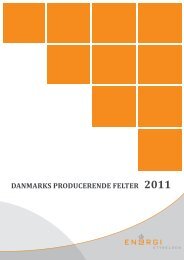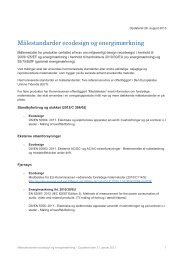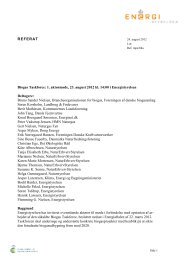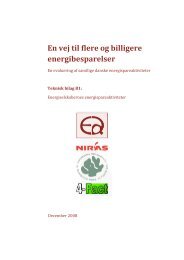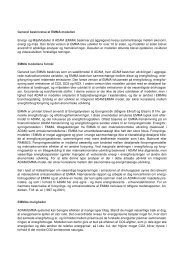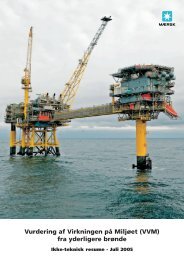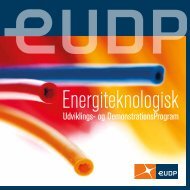Energy Strategy 2050 – from coal, oil and gas
Energy Strategy 2050 – from coal, oil and gas
Energy Strategy 2050 – from coal, oil and gas
You also want an ePaper? Increase the reach of your titles
YUMPU automatically turns print PDFs into web optimized ePapers that Google loves.
Track 1. Examples where the transition will commence immediately:<br />
Making buildings more efficient<br />
Extensive improvements in the energy efficiency of existing<br />
buildings should be implemented in connection with<br />
renovation <strong>and</strong> replacement in order for them to be cost<br />
effective. At the same time, efficiency improvements<br />
contribute immediately to meeting the 2020 targets.<br />
Electrification of heating <strong>and</strong> process installations<br />
Installations to heat buildings <strong>and</strong> for industrial processes<br />
have a long operational life; typically 25 years or more.<br />
Therefore it is advisable to start converting to electricity<br />
or heat pumps already now, as <strong>oil</strong> <strong>and</strong> <strong>gas</strong> furnaces <strong>and</strong><br />
b<strong>oil</strong>ers have to be replaced. This will also contribute to<br />
meeting the 2020 targets.<br />
Track 2. Examples where transition has to be prepared <strong>and</strong> planned:<br />
Planning of the energy infrastructure<br />
Integration of more fluctuating electricity production<br />
<strong>and</strong> electrification of end use involves a long-term need<br />
to develop the infrastructure. In this context, the <strong>gas</strong><br />
infrastructure of the future should also be planned with<br />
a view to enabling bio<strong>gas</strong> <strong>and</strong> other RE <strong>gas</strong>ses to take<br />
over <strong>from</strong> natural <strong>gas</strong> to a certain extent. This means<br />
that planning must commence immediately.<br />
Track 3. Examples of areas with a need for further research, development <strong>and</strong> demonstration:<br />
Research focussing on incorporating wind power<br />
Denmark’s vast wind resources provide future opportunities<br />
to harvest large parts of energy consumption <strong>from</strong><br />
the wind. Increased incorporation of wind requires, however,<br />
continued research <strong>and</strong> technological advances<br />
to reduce the energy costs <strong>and</strong> optimise the interplay<br />
of wind power with the electricity grid <strong>and</strong> electricity<br />
consumption, including methods to store the energy for<br />
a period.<br />
Box: 2.4 Examples of the initiatives in the three tracks<br />
Expansion of wind power<br />
Wind power seems to be cost effective <strong>and</strong> robust<br />
against future developments in fuel <strong>and</strong> CO2 prices,<br />
<strong>and</strong> it will be able to replace a great deal of the existing<br />
electricity capacity which will have to be replaced over<br />
the next 10-20 years.<br />
Increased use of biomass<br />
Biomass can play a central role in combination with wind<br />
production <strong>and</strong> possibly also in connection with <strong>coal</strong> <strong>and</strong><br />
CCS. In the short term, conversion to more biomass at<br />
power plants could reduce use of fossil fuels <strong>and</strong> thereby<br />
contribute to meeting the target of 30% renewable<br />
energy by 2020.<br />
Framework for future district heating production<br />
District heating production will change as consumption<br />
of fossil fuels at electricity <strong>and</strong> CHP plants is phased out.<br />
As this involves long-term investments, there is a need<br />
to set the framework for future district heating production<br />
now, through amongst other things strategic energy<br />
planning.<br />
Large-scale demonstration<br />
A large number of technologies may require large-scale<br />
testing before subsequent preparation for market <strong>and</strong><br />
full-scale implementation. For example, this applies for<br />
offshore wind, fuel cells for CHP production, smart grids,<br />
biorefineries, low-energy building <strong>and</strong> energy renovation.<br />
<strong>Energy</strong> <strong>Strategy</strong> <strong>2050</strong> <strong>–</strong> <strong>from</strong> <strong>coal</strong>, <strong>oil</strong> <strong>and</strong> <strong>gas</strong> to green energy.<br />
27




